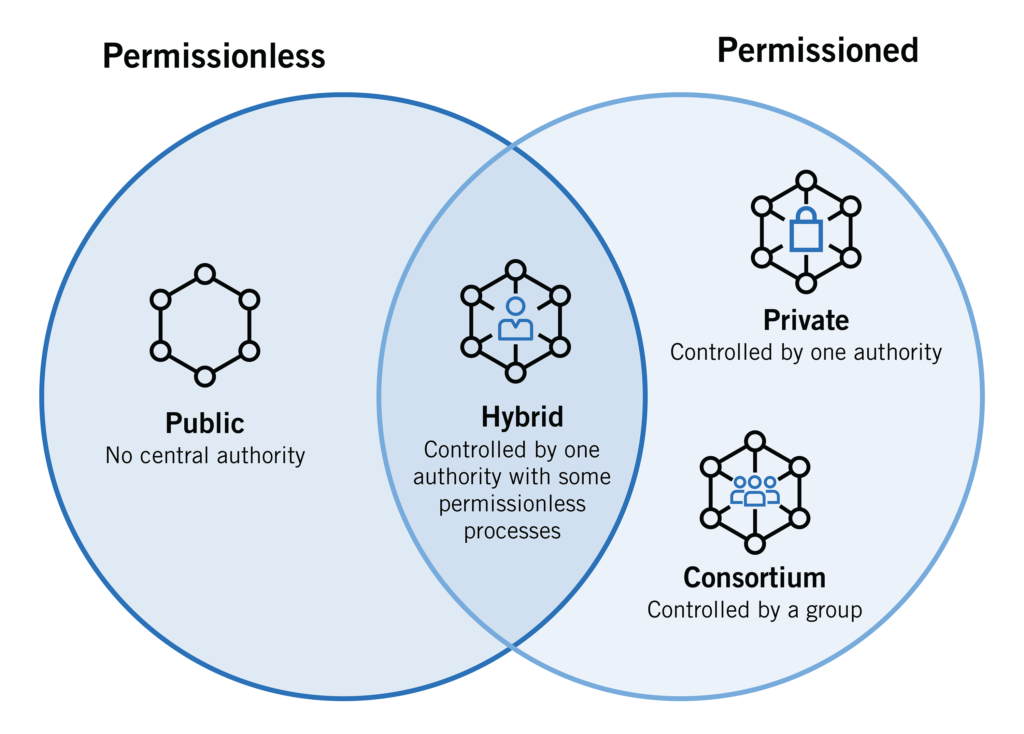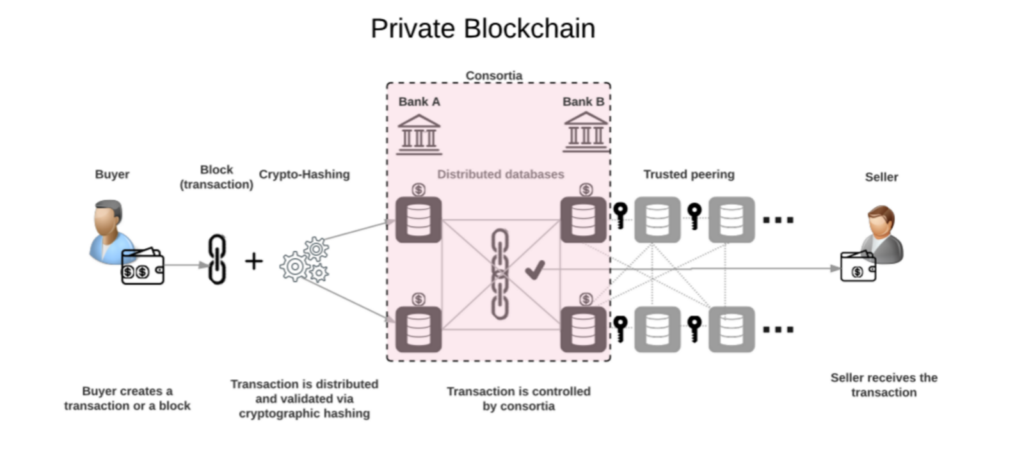- BurstIQ is a blockchain-based platform that enables the safekeeping, sale, sharing or licensing of data within several healthcare facilities.
- Private blockchain systems also offer better efficiency and lower attack surface.
- Walmart developed a private blockchain system to implement new provenance systems.
As we enter the second half of the year every eye is locked on the progress of blockchain-based organizations from different industries. In the past few decades, the web3 ecosystem has showcased how its capabilities can stretch beyond the financial sector.
Other industries like real estate, agriculture and the medical sector have adopted decentralized networks to establish a more efficient system. Fortunately, with these advancements in applicability, more users have turned to implementing blockchain technology within their business models. As a result, the use of the private blockchain system has significantly increased due to its added advantages over the public blockchain system. This article will highlight the blockchain trends in 2023 that are more focused on becoming private to avoid several hurdles that have significantly plagued public blockchain systems.
What are private blockchain systems?
Blockchain technology is the backbone of the web3 ecosystem. Its first successful application was Bitcoin which would usher in the development of the fintech industry. It took the success of several cryptocurrencies to bring blockchain technology global recognition. This ignited a ripple effect that affected other industries. Soon developers, entrepreneurs and innovators discovered that the web3 ecosystem could offer so much more. This led to the implementation of blockchain technology in different industries.
For instance, BurstIQ is a blockchain-based platform that enables the safekeeping, sale, sharing or licensing of data within several healthcare facilities. It utilizes publicly distributed ledgers that give complete control of information to patients directly while providing a decentralized database system.
As a result of such innovation, developers classified blockchain under four main categories; public, private, consortium and hybrid. Among the four, the last two are a variation of the first two, which blend some of their functionalities.

All four categories of blockchain systems.[Photo/Medium]
However, the web3 ecosystem is split between public and private blockchain systems.
In a nutshell, a private blockchain system is a condensed version of a decentralized network. A private blockchain system comprises a select group of participants or organizations. Unlike Bitcoin and Ethereum, private blockchain systems have several restrictions.
Also, Read What to Expect from Decentralized Finance (DeFi) in 2023.
This provides additional security. The concept of this decentralized network occurred shortly after developers could isolate blockchain technology from cryptocurrency. This led to the rapid growth of decentralized applications over the years. Its ability to limit the number of users and its applicability in different areas led to its rapid growth. Unfortunately, not many within the community took a positive turn to it.
This is because the private blockchain system may work against the primary goal of the web3 ecosystem. Public blockchains do not have any centralized entity within the entire decentralized network. For private blockchains, a network administrator or a centralized authority grants access to any participant to join the network.
Furthermore, within this web3 ecosystem, users have to follow certain protocols, requirements or procedures set by either the group controlling the network or the admin. Its centralized nature became a point of concern for most web3 developers. Some even went as far as deeming private blockchain systems asa n attempt to centralize blockchain systems.
Are private blockchain systems better?
Despite the web3 ecosystem containing a hurricane of opinions on private blockchain systems, its applicability exceeded all our expectations. As mentioned earlier, public blockchain systems have remained rigid to the goals of the web3 ecosystem. Unfortunately, due to this, the franchise has experienced countless breaches highlighting one of the top blockchain trends in 2023. Private blockchain systems have offered numerous advantages while compromising on the meaning of a decentralized network.
Due to its limited access, private blockchain systems have offered additional privacy. This allows any sensitive information to remain accessible to only authorized personnel and organizations, This advantage is one of the main reasons why blockchain trends in 2023 have revolved around the use of private blockchain systems.

A basic illustration of how private blockchains function.[Photo/HackerNoon]
Its decentralized network, coupled with increased privacy, allows organizations to retain sensitive data among concerned parties. This increases efficiency by providing a single secure network. In addition, several internal and external entities within an organization can communicate safely.
Private blockchain systems also offer better efficiency and lower attack surface. One of the primary faults of public blockchain systems is the sheer scale of their applicability. This may be advantageous in several sectors but maintaining such a system requires an immense amount of energy, equipment and personnel.
Also, Read Consortium Blockchain: The true depiction of Decentralization.
For instance, Ethereum had to shift to new consensus mechanisms to deal with its high energy consumption. This brought several performance and legality issues. The private blockchain is typically smaller depending on the number 0of participants.
This allows for faster transaction speed and offers lower transaction costs. Furthermore, it also reduces the attack surface of its decentralized nature. For instance, security investigators can identify a network breach that occurred among 100 users compared to 1000 users or in any public blockchain system.
Its small scale also offers greater control which comes in handy when dealing with sectors such as supply chain management, healthcare and finance. The decentralized network can host an organization with its affiliate partners and other external entities. This allows easier control and distribution of information. Furthermore, the protocols and rules defining the blockchain network are flexible and can easily change. With fewer participants reaching a consensus to change or update the decentralized network is more feasible as compared to public blockchain systems.
The rise of private blockchain trends.
When considering the blockchain trends, private blockchain systems have exponentially grown as compared to public. Despite its centralized take in the web3 ecosystem, we cannot deny it offers a more feasible approach when implementing blockchain in businesses. It is perfect for creating closed B2B transactional ecosystems among several business entities. Its advanced control over the decentralized systems enables it to evolve as time improves or as the organization adds several factors.
A prime example is Walmart which developed a private blockchain system to implement new provenance systems. According to their whitepaper, their new decentralized system allows Walmart suppliers to upload certificates of authenticity to the network securely. This has significantly improved the ability of the company to trace products back to the source.
De Beers also launched a private blockchain system, Tracr. The decentralized network securely verifies the authenticity and provenance of diamonds. This ensures that the organization does not acquire fake or blood diamonds from conflicting zones.
Furthermore, CBDCs are also an application of a private blockchain system. Despite the negative blockchain trend surrounding crypto within 2023, several governments have taken a positive viewpoint on the decentralized currency. For starters, countries such as Kenya, South Africa and Tanzania have taken a step toward implementing CBDCs.
South Africa has already drafted several legal frameworks complementing its decision on crypto. Nigeria is the first African country to implement a CBDC. Furthermore, its new government has hinted at several projects to revive it’s failing eNaira private blockchain system.
Also, Read The recent crypto slump and the tough lessons on custody and control.
Africa’s fintech industry is a rising blockchain trend that heavily implements private blockchain systems. In 2022, the industry received over $1.4 billion in investments showcasing how current high growth rate of fintech startups in Africa. According to Statista, the industry will generate at least $65 billion with a 32% CAGR by 2030.
Private blockchain systems have ushered in a new wave of innovation in other industries. Its heightened control and additional features have led to the growth of more decentralized applications over the past few decades. One of the vital topics in blockchain trends in 2023 is the impact of private blockchain applications in industries.
For instance, the gaming sector has significantly improved after it merged with the web3 ecosystem. Blockchain gaming holds a formidable 77% dominance and accounts for 550 million transactions within the web3 ecosystem. The use of private blockchain systems has improved its efficiency and use.
Conclusion
Despite private blockchain systems highlighting blockchain trends, it still faces heavy opposition. The fact remains that its heightened control is a double-edged sword. It offers improved performance and increased security but ultimately infringes on the primary goal of the web3 ecosystem.
According to Adedayo Adebajo, Managing Director of Jelurida Africa, the private blockchain system poses many risks to integrity. A centralized entity can doctor information if they access the network’s smart contract. Furthermore, some organizations can alter the rules governing private blockchain systems favouring them while exploiting other users.
In 2022, many crypto scams occurred primarily in private blockchain systems resulting in major issues.
Despite spit these drawbacks, the web3 ecosystem is still;l experiencing rapid use of the private ecosystem. If developers implement such a decentralized system efficiently it does offer additional benefits.
Public and private blockchains are steadily improving, and we may see global adoption by 2030 if we manage to survive this crypto winter,
- SEO Powered Content & PR Distribution. Get Amplified Today.
- PlatoData.Network Vertical Generative Ai. Empower Yourself. Access Here.
- PlatoAiStream. Web3 Intelligence. Knowledge Amplified. Access Here.
- PlatoESG. Automotive / EVs, Carbon, CleanTech, Energy, Environment, Solar, Waste Management. Access Here.
- BlockOffsets. Modernizing Environmental Offset Ownership. Access Here.
- Source: https://web3africa.news/2023/07/06/news/private-blockchain-systems-trending-mid-2023/
- :has
- :is
- :not
- 100
- 2022
- 2023
- 2030
- 32
- a
- ability
- access
- accessible
- According
- Accounts
- acquire
- added
- addition
- Additional
- Adds
- admin
- adopted
- Adoption
- advanced
- advancements
- ADvantage
- advantageous
- advantages
- Affiliate
- africa
- African
- After
- against
- agriculture
- All
- allows
- already
- also
- among
- amount
- an
- and
- any
- Application
- applications
- approach
- ARE
- areas
- around
- article
- AS
- ASA
- At
- attack
- authenticity
- authority
- authorized
- avoid
- B2B
- back
- Backbone
- basic
- BE
- became
- because
- becoming
- benefits
- Better
- between
- Beyond
- Billion
- Bitcoin
- bitcoin and ethereum
- Blend
- blockchain
- blockchain applications
- blockchain gaming
- Blockchain network
- blockchain system
- blockchain technology
- blockchain trends
- blockchain-based
- blockchain-based platform
- blockchains
- blood
- breach
- breaches
- bring
- brought
- business
- businesses
- but
- by
- cagr
- CAN
- cannot
- capabilities
- categories
- CBDC
- CBDCs
- centralized
- certain
- certificates
- chain
- change
- classified
- closed
- comes
- communicate
- community
- company
- compared
- complete
- comprises
- compromising
- concept
- Concern
- concerned
- Conflicting
- Consensus
- considering
- consortium
- consumption
- contract
- control
- controlling
- Costs
- could
- countries
- country
- coupled
- Creating
- crypto
- crypto scams
- crypto slump
- Crypto Winter
- cryptocurrencies
- cryptocurrency
- Currency
- Current
- Custody
- data
- Database
- deal
- dealing
- decades
- decentralized
- Decentralized Applications
- Decentralized Finance
- decentralized finance (DeFi)
- decentralized network
- decentralized networks
- decision
- DeFi
- defining
- Depending
- Despite
- developed
- developers
- Development
- different
- directly
- Director
- discovered
- disruptive
- distributed
- distributed ledgers
- distribution
- do
- Doctor
- does
- Dominance
- drafted
- drawbacks
- due
- Earlier
- easier
- easily
- ecosystem
- Ecosystems
- effect
- efficiency
- efficient
- efficiently
- either
- enables
- ENAIRA
- energy
- Energy Consumption
- ensures
- Enter
- Entire
- entities
- entity
- entrepreneurs
- equipment
- establish
- estate
- ethereum
- Even
- Every
- evolve
- example
- exceeded
- expect
- expectations
- experienced
- experiencing
- exponentially
- external
- eye
- faces
- facilities
- fact
- factors
- failing
- fake
- far
- faster
- faults
- feasible
- Features
- few
- fewer
- finance
- financial
- Financial sector
- fintech
- fintech startups
- First
- flexible
- focused
- follow
- For
- formidable
- Fortunately
- four
- frameworks
- franchise
- from
- function
- functionalities
- Furthermore
- gaming
- generate
- Give
- Global
- goal
- Goals
- governing
- Government
- Governments
- grants
- greater
- Group
- grown
- Growth
- had
- Half
- handy
- Have
- healthcare
- heavily
- heavy
- heightened
- High
- Highlight
- highlighting
- holds
- host
- How
- HTTPS
- Hurdles
- hurricane
- Hybrid
- identify
- if
- immense
- Impact
- implement
- implementation
- implementing
- implements
- improved
- improving
- in
- In other
- increased
- Increases
- industries
- industry
- information
- Innovation
- innovators
- instance
- integrity
- internal
- Investigators
- issues
- IT
- ITS
- join
- kenya
- Last
- least
- Led
- ledgers
- Legal
- Lessons
- Licensing
- like
- LIMIT
- Limited
- limited access
- locked
- lower
- Main
- Maintaining
- major
- major issues
- manage
- management
- managing
- Managing Director
- many
- max-width
- May..
- meaning
- medical
- mentioned
- million
- models
- more
- more efficient
- most
- much
- Nature
- negative
- network
- networks
- New
- Nigeria
- number
- numerous
- occurred
- of
- offer
- offered
- Offers
- on
- ONE
- only
- Opinions
- opposition
- or
- organization
- organizations
- Other
- our
- over
- participants
- parties
- partners
- past
- patients
- perfect
- performance
- Personnel
- plagued
- platform
- plato
- Plato Data Intelligence
- PlatoData
- Point
- poses
- positive
- primarily
- primary
- Prime
- privacy
- private
- Private blockchains
- procedures
- Products
- Progress
- projects
- protocols
- provenance
- provides
- providing
- public
- public blockchain
- publicly
- rapid
- Rate
- reaching
- Read
- real
- real estate
- reasons
- recent
- recognition
- reduces
- remain
- remained
- remains
- Requirements
- requires
- restrictions
- result
- resulting
- retain
- Revive
- revolved
- rigid
- Ripple
- Rise
- rising
- risks
- rules
- safely
- sale
- Scale
- scams
- Second
- sector
- Sectors
- secure
- securely
- security
- see
- sensitive
- set
- several
- sharing
- shift
- Shortly
- showcased
- showcasing
- significantly
- single
- Slump
- small
- smaller
- smart
- smart contract
- So
- some
- soon
- Source
- South
- South Africa
- speed
- split
- Startups
- Step
- Still
- success
- successful
- such
- suppliers
- supply
- supply chain
- supply chain management
- Surface
- Surrounding
- survive
- system
- Systems
- Take
- taken
- Technology
- that
- The
- The Source
- their
- Them
- These
- they
- this
- time
- to
- took
- top
- Topics
- tough
- toward
- Trace
- transaction
- transaction costs
- transaction speed
- transactional
- Transactions
- Trend
- Trends
- true
- TURN
- Turned
- two
- typically
- Ultimately
- under
- unfortunately
- unlike
- Update
- use
- users
- utilizes
- version
- vital
- Walmart
- was
- Wave
- we
- Web3
- Web3 Ecosystem
- went
- when
- which
- while
- Whitepaper
- why
- will
- Winter
- with
- within
- Work
- would
- year
- years
- zephyrnet
- zones













